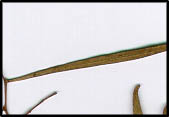South West Slopes Revegetation Guide
Acacia salicina
Cooba
Select from the following for detailed images.
Species Information
| Synonyms |
|
| Common Names |
Cooba |
| Family |
Mimosaceae - Mimosa family. |
| Name Origin |
From Latin salicis, referring to pendulous, willow-like habit. |
Specimen Data - CSU 1574
| Location |
Wagga Agricultural Centre. NSW |
| Notes |
Grown specimen. Zone: Easting: Northing: |
| Collector |
Sutherland, J.R. |
Date |
01/01/1989 |
| Determined By |
Kent, Kylie |
Date |
20/05/2000 |
South West Slopes Revegetation Guide Information
| Regional: |
Becomes more common west of Olympic Highway. |
| Australia: |
Qld, NSW, Vic, SA. |
| Habitat: |
Dry sclerophyll forest, shrubland and woodland in semi-arid regions. Mostly creek banks, and flat alluvial plains and floodplains. |
| Habit: |
Erect or spreading shrub or tree, 3-10 m high. Brownish, finely fissured bark and deep-green foliage on willow-like drooping branches. Often in dense clumps. |
| Similar Species: |
|
| Site Preference: |
|
| Characteristics: |
Long-lived. Wind-firm. 'Leaves' contain large amounts of tannin. |
| Flowering: |
Pale yellow to almost white, usually Feb-Jun. |
| Seed Collection: |
Dec-Jan. Good crops every few years. |
| Propagation: |
From seed ( 8 viable seeds per gram). |
| Regeneration: |
regeneration. Encourage suckering by root ripping or disturbance. |
| Timber: |
Close-grained, tough, heavy, dark-brown and attractively marked. Used in furniture joinery and craft, and said to rival Blackwood (Acacia melanoxylon) timber. Takes a high polish. Used for making bullock yokes and cart shafts in pioneering days. |
| Shade and Shelter: |
Excellent low to medium-level cover in windbreaks, due to bushiness and suckering. |
| Land Protection: |
Valuable in maintaining riverbank stability and for general erosion control, where its suckering is an advantage. Legume improves soil fertility through 'fixing' nitrogen. |
| Wildlife: |
Excellent habitat. Native birds and insects eat seed appendages. |
| Ornamental: |
Useful attractive species for gardens and parks, particularly in dry areas. Responds to water during dry periods. |
| Other: |
Tannin-rich bark used to poison fish. 'Leaves' reputedly burnt and ash smoked to produce a narcotizing effect. Seeds eaten in some areas. Excellent drought fodder for sheep and cattle. |
Note: The following information presented is only a guide, as plant characteristics vary depending on provenance (the plant's locality).
| Site/Preferred Habitat : |
creekbanks/ flats |
| Rainfall(mm) : |
300 |
| Growth Rate : |
moderate |
| Tolerates : |
salt; drought |
| Resents : |
frost when young |
| Uses & Comments : |
windbreak; fuel; timber; fixes nitrogen; wildlife |
Return to Database List
